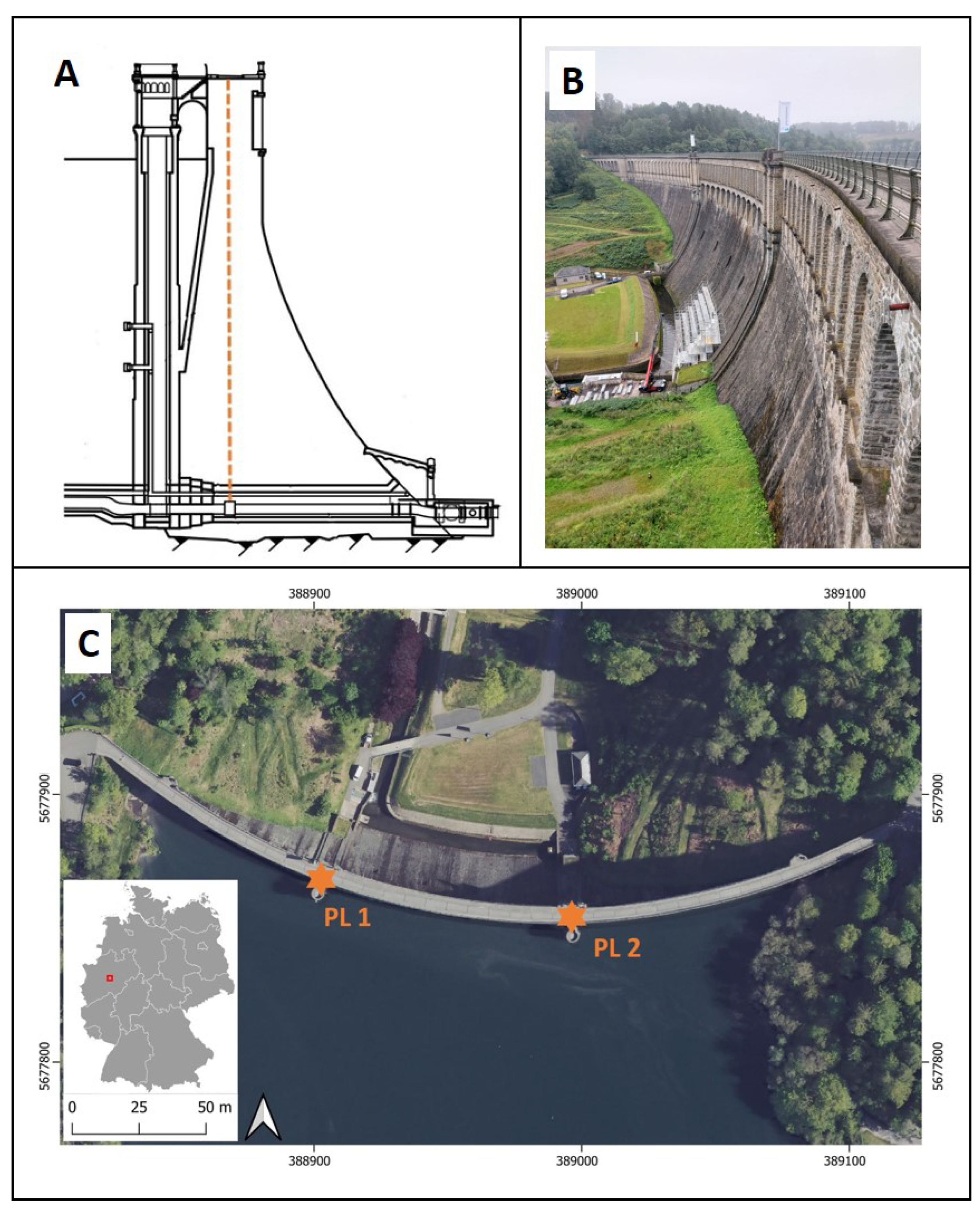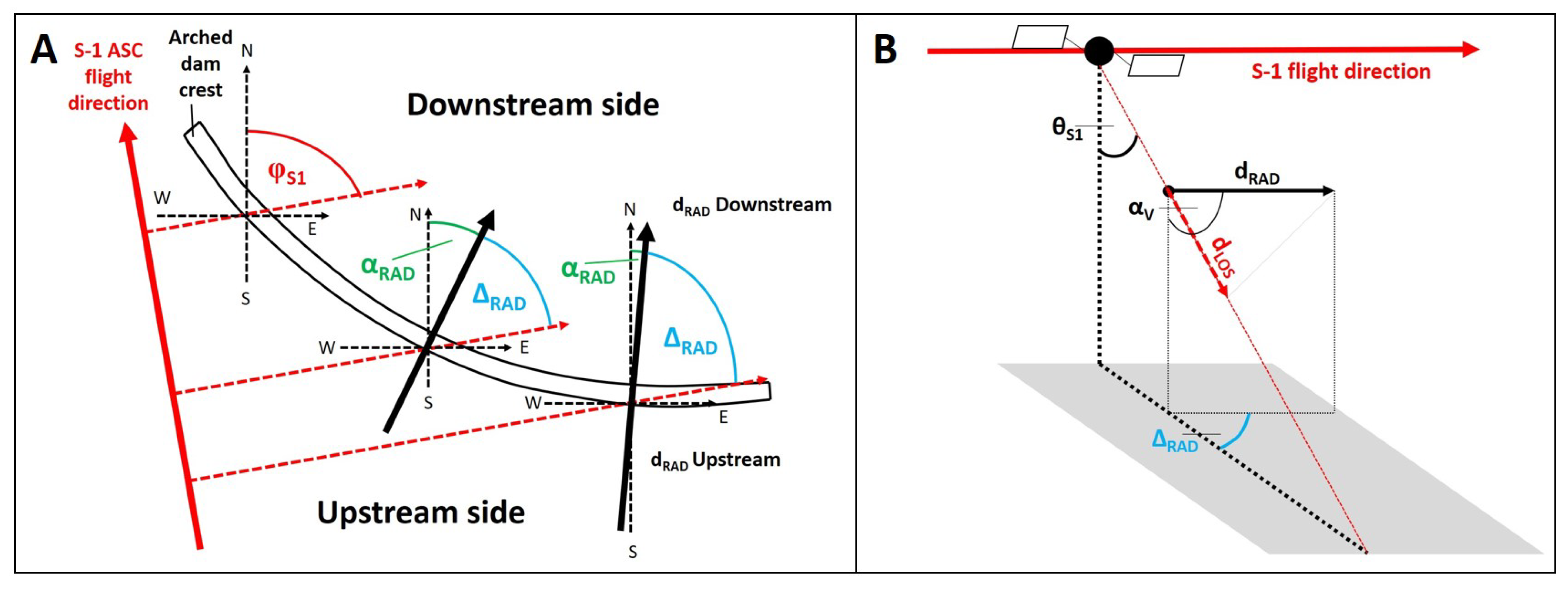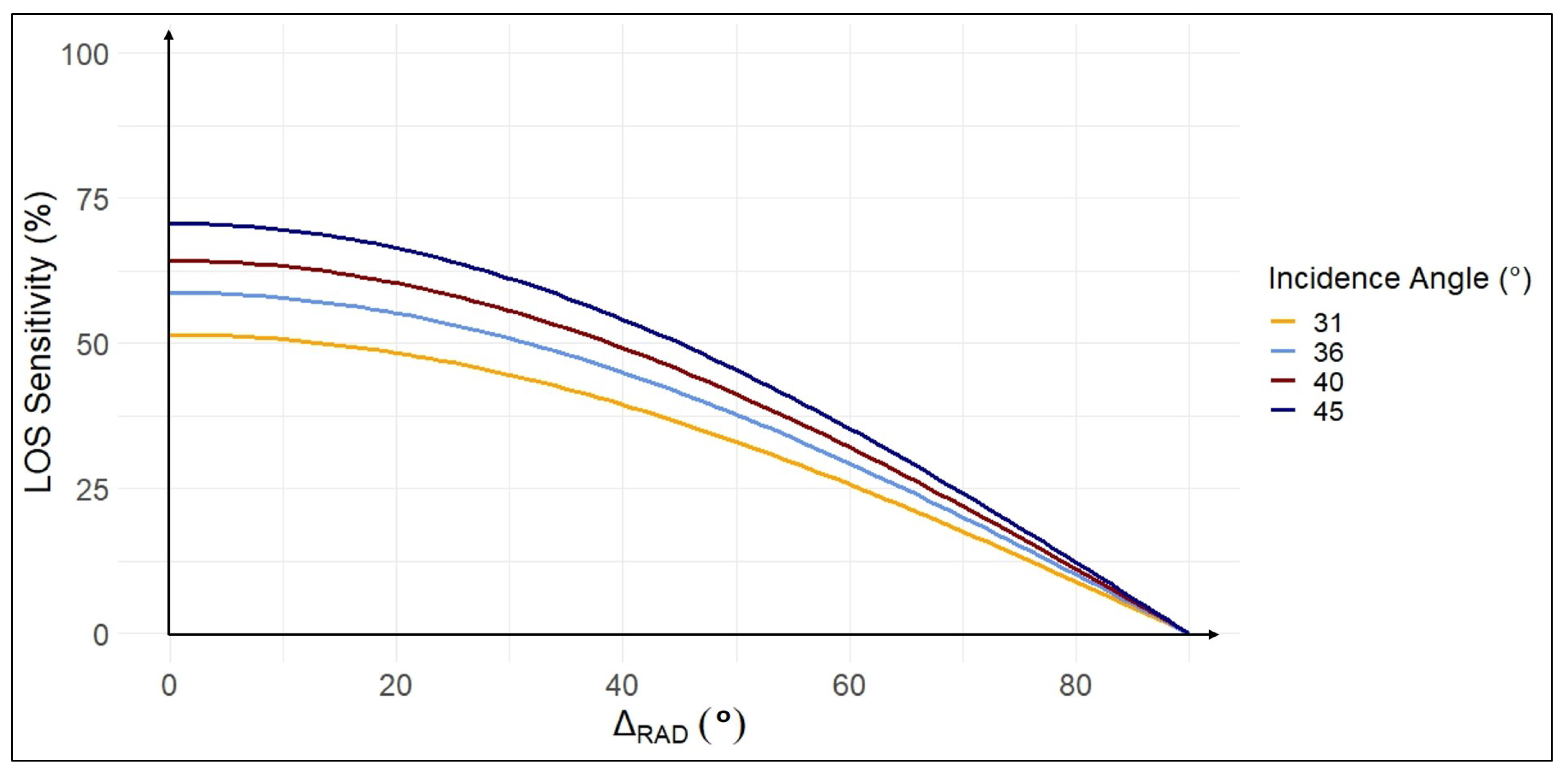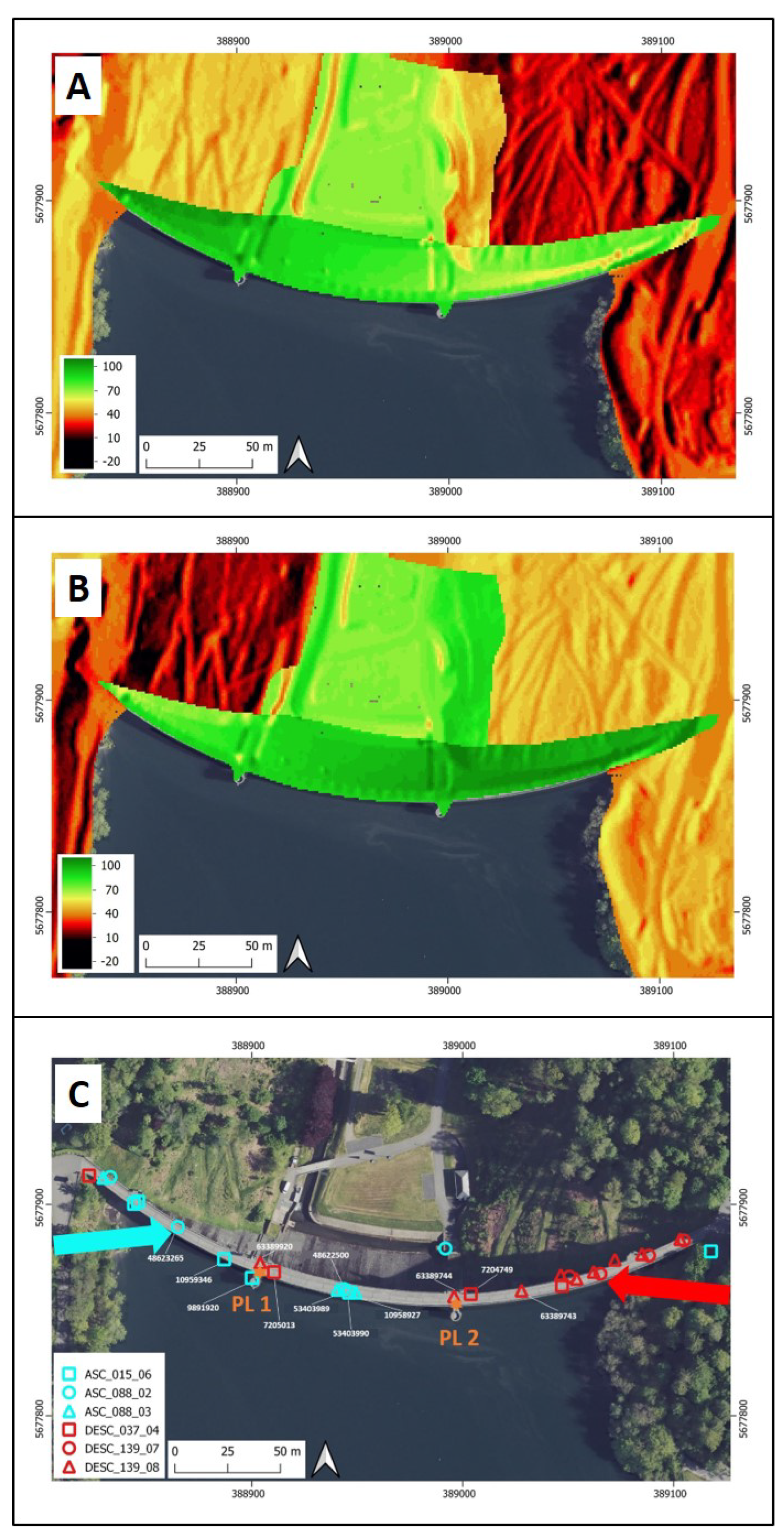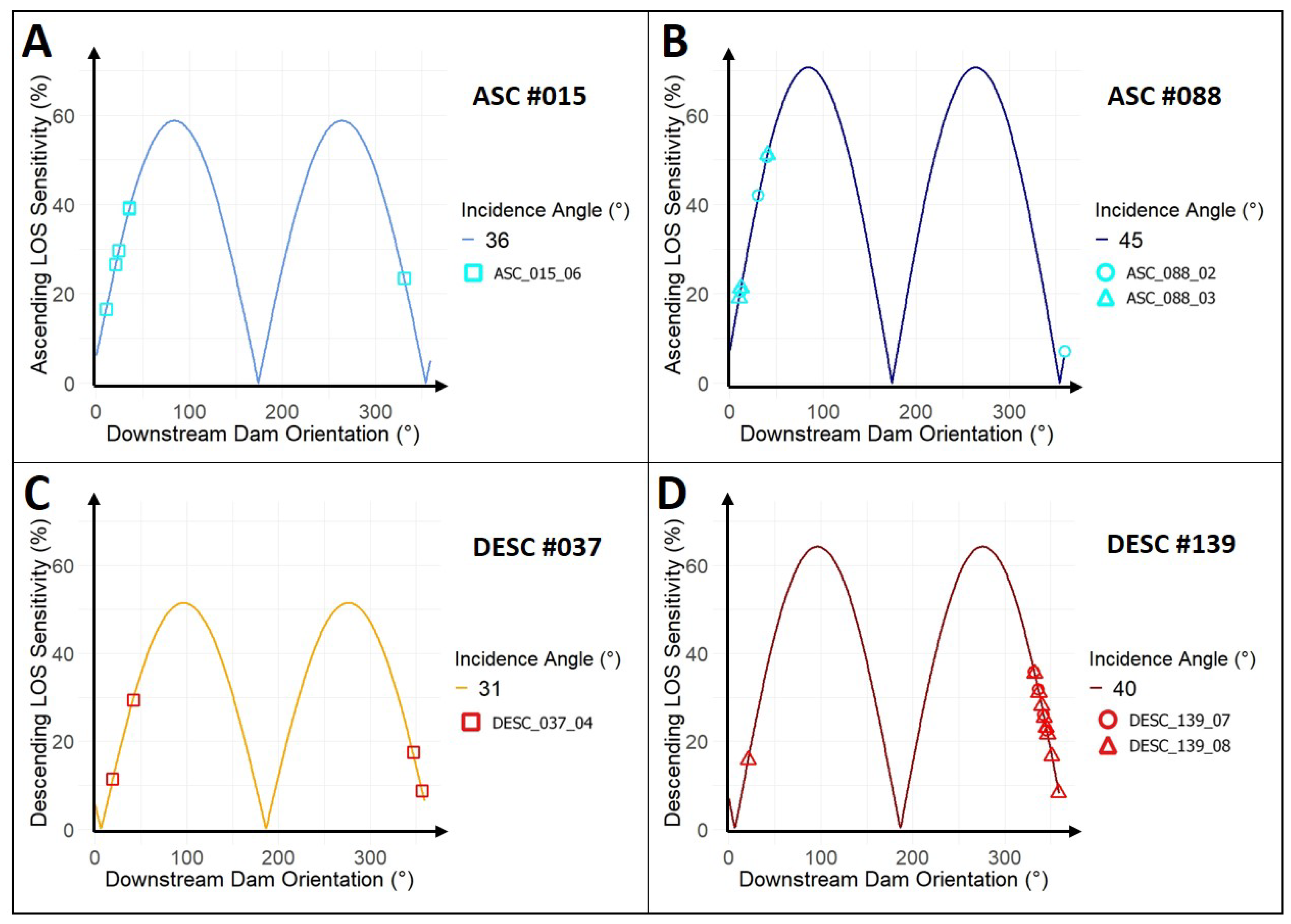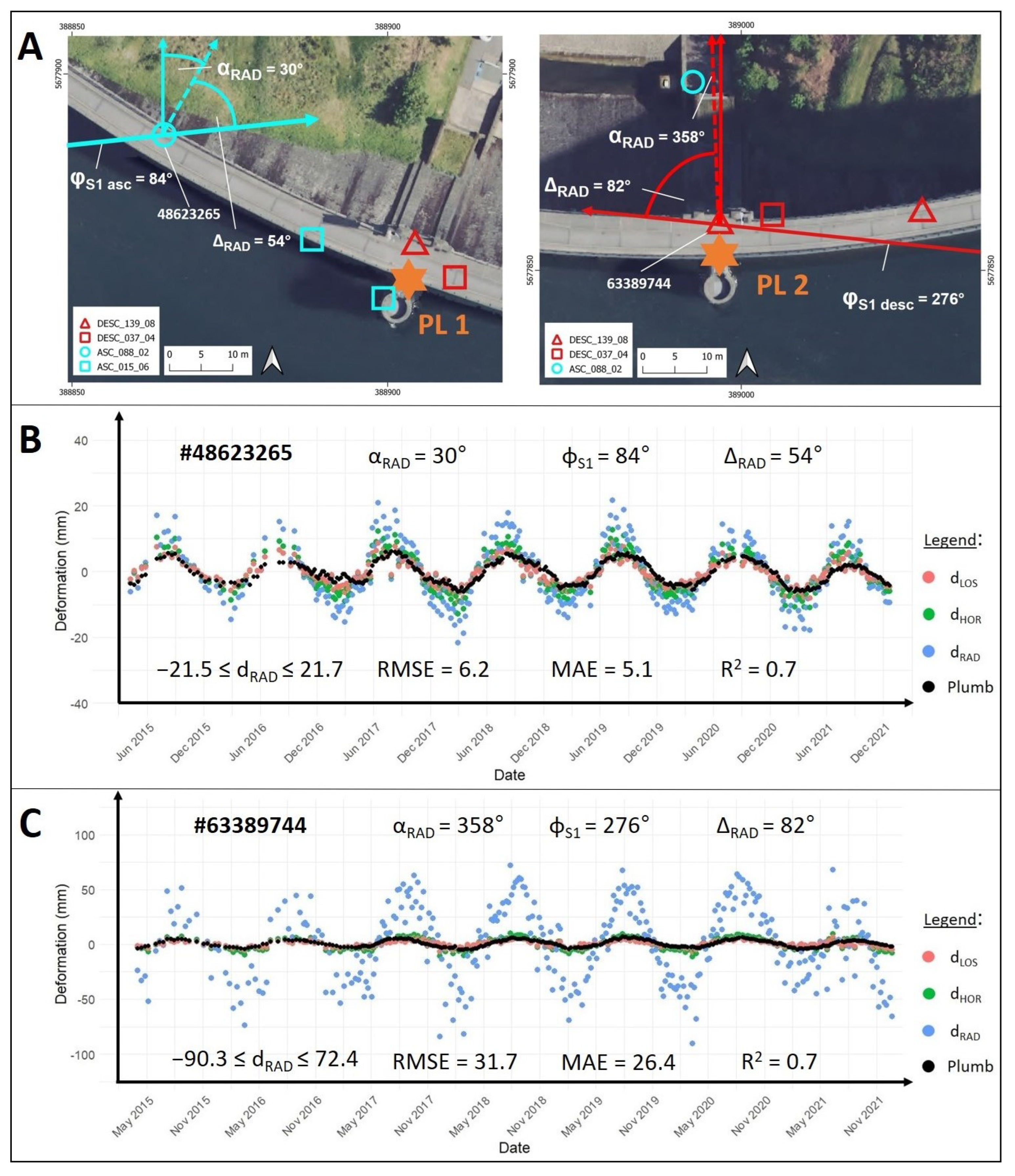1. Introduction
As critical infrastructure, dams require regular monitoring to ensure their safe operation. Depending on their size, a comprehensive measurement setup is installed to monitor deformations over short- and long-term periods. These measurements are typically conducted using in situ geodetic methods such as pendulum systems and trigonometry [
1]. Although trigonometric measurements cover the entire dam, field campaigns are time-consuming and are often conducted only twice a year. Pendulum systems enable continuous monitoring, usually with one or more measurements per day [
2]. However, they are not installed on every dam and only capture deformations at specific locations (e.g., in the middle of the crest), which may not be representative of deformation patterns across other dam sections.
Advancements in multi-temporal synthetic aperture radar interferometry (MT-InSAR) have addressed these challenges by combining temporally dense time series with a high number of observation points. Interferometric techniques, such as the persistent scatterer interferometry (PSI), enable the monitoring of deformations with millimeter-level precision. With the implementation of ESA’s Sentinel-1 (S-1) data into nationwide ground motion services (GMSs), persistent scatterer (PS) time series are now freely available as analysis-ready datasets. In Germany, the German ground motion service (
Bodenbewegungsdienst Deutschland, BBD) provides data spanning from 2015 to 2021 [
3]. With revisit intervals ranging from 6 to 12 days, the BBD offers valuable insights into the structural behavior of dams and their long-term deformation characteristics.
1.1. MT-InSAR Employed for Dam Monitoring in Scientific Studies
MT-InSAR has evolved from a niche technique to a valuable monitoring tool, with its effectiveness in deformation analysis demonstrated on embankment dams [
4,
5,
6,
7,
8,
9,
10,
11], gravity dams [
2,
12,
13,
14,
15,
16], arch-gravity dams [
17], and tailings dams [
18,
19]. Most of these studies are based on data that have been individually processed for each analysis. However, due to time constraints and limited technical expertise, dam operators may prefer analysis-ready datasets over independently processing PS data. This underscores the necessity of evaluating the potential of PS time series provided through GMS. Few studies have focused on the use of analysis-ready PS data for incorporation into operational monitoring programs.
Table 1 shows a selection of recent studies. Even et al. [
20] compared the accuracy of BBD time series with those provided by the European ground motion service (EGMS) against external leveling and GNSS data, reporting slightly higher biases in the EGMS data.
Marchamalo-Sacristán et al. [
11] examined the integration of MT-InSAR with other monitoring techniques in a pilot monitoring system for embankment dams in Spain. While this study focused primarily on developing an application programming interface (API) for operational monitoring, it did not consider analysis-ready PS data. Dubois et al. [
15] investigated the deformation of a gravity dam in Germany using S-1 data from the BBD. The recent nature of these studies highlights the increasing efforts in this field; however, PS data have not yet been integrated into operational monitoring procedures.
1.2. Challenges for Incorporation into Operational Monitoring Programs
Although the potential of PSI for dam monitoring has been well researched, several challenges have so far hindered the integration of this technique into existing monitoring methods [
11]. These challenges include administrative and technical barriers related to data processing, interpretation, and integration:
Lack of interoperability: The rigidity of existing monitoring procedures presents a considerable challenge, as they may not be easily adaptable to new technologies. This includes discrepancies in data formats and incompatibility with different monitoring software. Standardization of data formats is crucial to fully leverage advanced technologies such as PSI [
11].
Lack of interpretability: One of the primary challenges for dam operators is the interpretation of PS-derived deformations, which are measured in the sensor’s line of sight (LOS) [
21,
22]. Since LOS deformations include both vertical and horizontal displacement components, direct comparison with pendulum data, acquired radially to the dam, is challenging. Given that the highest deformation on a gravity dam typically occurs perpendicular to the dam crest, PS data must be converted to ensure comparability with in situ measurements, improving interpretability for dam operators.
Lack of standardized workflows: For effective implementation, the benefits and limitations of PSI for dam monitoring must be more clearly defined. Since PSI applications are highly case-specific, greater effort is required to assess their feasibility for individual dams. The development of standardized guidelines could facilitate this assessment, addressing aspects such as
A: Assessment of topography: Steep slopes and other topographic features can influence the applicability of PSI due to the sensor geometry (e.g., layover, foreshortening, shadow). Therefore, it is crucial to evaluate the impact of topography prior to analysis.
B: Assessment of land cover: Different land cover types affect the number of detected PS points. Temporal coherence is usually low in vegetated areas, making PSI applications more challenging.
C: Assessment of dam type: Since the number of PS points is essentially dependent on the material properties of the building, the dam type is one of the key factors for successful PS analysis. In contrast to gravity or arch dams, typically made of masonry or concrete, embankment dams are built on various compositions of rock or soil, often covered by vegetation. This can limit the detection of PS points.
D: Assessment of dam orientation: The dam’s orientation relative to the sensor’s look direction is one of the most important criteria for interpreting PSI-derived deformations. Most satellites used for infrastructure monitoring, such as Cosmo-SkyMed, TerraSAR-X, and Sentinel-1 operate with an east–west-looking direction. Consequently, dams oriented north–south provide the highest sensitivity for detecting deformations perpendicular to their crest.
1.3. Research Approach
This study evaluates the potential of BBD-provided PS time series for interpreting radial deformations on a gravity dam and comparing them to traditional in situ pendulum data. We propose a two-stage assessment procedure: First, we analyze the selected dam concerning key factors such as topography and land cover to determine its suitability for PS analysis. Second, we assess the interpretability of radial PS time series for comparability with pendulum data, highlighting the impact of dam orientation on PS time series accuracy. By introducing a novel index applicable to various types of infrastructure, the sensitivity of LOS measurements to radial deformations can be effectively assessed. To the best of our knowledge, this study is the first to assess the feasibility of incorporating freely available, analysis-ready PS data from the BBD into the monitoring program of gravity dams.
5. Discussion
This study examined the applicability of PS datasets for operational dam monitoring, presenting a selection of key considerations for assessing the suitability of individual dams for PS-based monitoring approaches. Importantly, these considerations represented only a subset of relevant factors and can be supplemented by additional variables based on the type of dam investigated or the specific requirements of dam operators.
As demonstrated, a priori analyses are beneficial in evaluating the general suitability of individual dams for PS-based monitoring. Geometric distortions (i.e., layover, foreshortening, and shadow) could influence their monitoring capability due to challenging topographic conditions. Therefore, a priori analyses are crucial in highlighting the limitations of the PS technique, as not all dams are equally well-suited.
The dam type and its relative orientation to the sensor’s look direction were among the most important criteria for interpreting PS data and ensuring comparability to in situ geodetic methods. Variations in
also contributed to minor variations in the deformation amplitude of the time series. However, as can be seen in
Figure 6, these variations accounted for only a fraction of the total deviation between
and
(see
graph). Atmospheric effects can also impact radar signal quality, primarily due to variations in atmospheric pressure, temperature, and water vapor. Fluctuations in water vapor—especially in the lower troposphere (i.e., up to 2 km above ground)—can introduce significant, localized phase artifacts due to turbulent mixing [
40]. These variations in water vapor content differ between morning and evening, potentially affecting the quality of MT-InSAR measurements and contributing to differences between ascending and descending acquisitions. Integrating information on the signal-to-noise ratio of PS points can be useful for filtering those with high noise. The BBD datasets used in this study provide the SNR of each PS point (see
Appendix C Table A1 and
Table A2), thereby facilitating decision-making.
As shown in
Figure 5, the sensitivity to radial deformations between ascending and descending S-1 tracks differed by only 12°. However, due to the arched shape of the Ennepe Dam, the sensitivity to radial deformations varied considerably across different PS points (see
Figure 6). Notable differences in deformation amplitude can arise between PS points, depending on the data stack and the projection used for analysis. The fact that the radial time series exceeded the deformation amplitude of the pendulum data by a significant margin limits their applicability for operational dam monitoring. Notably, the required monitoring accuracy for each dam varies depending on factors such as its dimensions, material composition, and interaction with the foundation bedrock [
1,
5,
41]. According to Corsetti et al., concrete dams, such as the Ennepe Dam, require measurement precision approximately five times higher than that needed for embankment dams [
5]. This may necessitate filtering adequate points or deriving segments with high radial deformation sensitivity to meet operational standards. Such a procedure could also be integrated into a priori assessments to support decision-making. On the Ennepe Dam, the specified accuracy for concrete dams (i.e., 5 mm) [
5] was only achieved by one PS point (
#48623265: MAE = 5.1 mm, RMSE = 6.2 mm), based on its radial time series. Importantly, this does not necessarily imply that a PS point significantly overestimating the radial deformation provides no valuable information regarding the LOS geometry. For dams without a vertical monitoring system, the LOS time series—which combines vertical and horizontal deformations—may serve as a crucial supplementary data source for dam operators assessing structural stability. At this stage, we refrain from making recommendations regarding which acquisition geometry to use for deformation assessment, noting that the decision remains at the discretion of the dam operators, based on their individual needs.
For a comprehensive monitoring strategy, it is beneficial to incorporate both ascending and descending orbits where available. Using data from both directions increases the PS density and allows for a more comprehensive monitoring of a dam. As demonstrated for the Ennepe Dam, BBD data provided sufficient PS points to monitor all dam sections. However, this does not apply to all cases, as the number of detected PS points varies from dam to dam.
Appendix D Table A3 and
Table A4 give an overview of the dams operated by the Ruhrverband, illustrating the approximate number of detected PS points based on dam type and crest length. Importantly, the number of detected PS points depends not only on the radar signal’s wavelength, but also on the dam’s material properties, size, alignment with the satellite, and the sensor’s spatial resolution. Certain dam sections may not be adequately monitored due to insufficient PS points, limiting the applicability of BBD datasets on these dams. As for the Ruhrverband, this applies to four of the seven dams illustrated in
Appendix D Table A3 and
Table A4, detecting less than 10 PS points. This highlights the importance of a priori assessments to support decision-making. Notably, we used BBD data, providing filtered PS point datasets based on their temporal coherence to meet the required quality standards. The dataset analyzed in this study (i.e., spanning from 2015 to 2021) was provided with a temporal coherence threshold of >0.75. As an alternative, data from the European ground motion service (EGMS), which now includes LOS measurements in its latest update, can be considered. Unlike BBD data, EGMS employs multi-temporal interferometric processing that integrates both persistent scatterers and distributed scatterers (DSs) [
20,
42]. While the PS technique relies on single dominant scatterers with a high-quality interferometric phase [
43], the DS approach focuses on areas of moderate coherence, where multiple neighboring pixels share similar reflectivity values as they belong to the same object [
44]. Unlike PS, DS lack a single dominant reflector, making them particularly advantageous in rural areas with lower coherence. The combination of both, as implemented in EGMS, increases the number of measurement points available for deformation monitoring. However, filtering out points with low temporal coherence, poor signal-to-noise ratio, or unfavorable sensor orientation remains essential for reliable analysis. Otherwise, several dozen PS points on a dam may be far less effective for decision-making than a smaller number of high-quality points. Finally, considering that many dams have only a single pendulum system installed—if any—limiting deformation assessments to one specific point on the dam, the PS technique remains valuable even when only a small number of PS points are detected on the dam.
Further considerations imply that radial deformation analysis is only possible on dams with no discernible vertical deformation [
2]. Due to their foundation on solid rock formations [
45], gravity dams and arch dams are well-suited for this approach, as vertical deformations are typically much smaller than horizontal deformations. Trigonometric measurements on the Ennepe Dam confirmed that vertical deformation accounts for only a fraction of the total movement [
37]. This assumption does not hold for embankment dams affected by the consolidation of fill material. In such cases, PS data in the sensor’s line of sight may not be directly comparable to in situ radial measurements but can be used as a supplementary data source for deformation interpretation. Ultimately, the decision regarding which geometry to use rests with the dam operators. Both LOS and radial deformations can be implemented for operational use, regardless of dam type.
The ability to provide analysis-ready data in different geometries positions nationwide ground motion services as reliable data providers for dam operators. With annual updates, long-term deformations can yet be effectively monitored [
15]. With freely available PS data provided in common formats (.csv/.gdb), technical integration into existing monitoring programs could be possible at minimal cost. However, a key challenge lies in the implementation of near-real-time data, as current BBD datasets only cover time series from 2015 to 2021 [
3]. Dam operators often require near-real-time assessments to detect potentially critical deformations on their infrastructure—particularly during extreme weather events—which is not yet integrated. Implementing this functionality requires greater effort for quicker decision-making and operational applicability of BBD datasets.
A dedicated API could facilitate the assessment of PSI applications for individual dams by standardizing workflows and streamlining the data [
11]. Integrating near-real-time processing, optionally enhanced with complementary X-band data, could provide deeper insights into deformation characteristics on a local scale. Additionally, the functionality of this service could be tailored to meet the specific requirements of dam operators.
6. Conclusions
In this study, we assessed the feasibility of analysis-ready PS data provided by the German ground motion service for operational dam monitoring. Two key aspects proved crucial in evaluating the applicability of the PS technique on gravity dams: first, determining the dam’s general suitability for PS analysis using the CR-Index, which incorporates topography and land cover information to identify areas with good radar visibility; and second, assessing the interpretability of BBD data for radial deformations. For this purpose, we introduced a novel index that quantifies the radial sensitivity of PS points on the dam.
Freely available BBD time series demonstrated fair agreement with in situ pendulum data (up to = 0.7) for many PS points, highlighting their potential for integration into operational monitoring procedures. The capability to provide consistent deformation data with frequent updates positions PSI as a valuable complement to time-consuming in situ campaigns. Importantly, not all dams are equally suited for a PS-based monitoring strategy. A priori analysis of the dam’s characteristics (i.e., topography, land cover, dam type, dam orientation) is crucial to assess its general feasibility for PSI applications.
The sensitivity of PS data to deformations perpendicular to the dam wall emerged as an essential criterion for interpretability. For up to 20°, the LOS sensitivity captures approximately 50 to 70% of the true radial deformation, depending on the satellite’s incidence angle. This condition is best fulfilled by dam crests aligned in a north–south direction. However, when exceeds 20°, the sensitivity to LOS deformations decreases considerably. The Ennepe Dam investigated in this study exhibited generally low LOS sensitivity to radial deformations due to its east–west orientation, with exceeding 20° for all PS points. As a result, the estimated radial deformation amplitudes were up to an order of magnitude greater (−90 mm 70 mm) than those measured by pendulum systems. For these points, errors ranged from 6 to 43 mm in RMSE and from 5 to 35 mm in MAE. Eliminating points with low temporal coherence or an unfavorable alignment with the sensor should be considered before interpreting their radial deformations. For dams that are not optimally aligned with the sensor, LOS data can serve as a valuable supplementary data source—combining both horizontal and vertical deformation components. The final decision on which acquisition geometry to use remains at the discretion of the dam operators. For integration into operational monitoring programs, greater effort must be spent on near-real-time updates of BBD datasets.
Future research could focus on developing a freely available API specifically designed for dams, enabling the transfer of the proposed methodology to a nationwide dam monitoring service with standardized data products.
